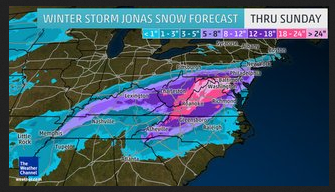Is your school/district ready for extended school closure due to weather or other factors? We are preparing for a blizzard here in Virginia as folks in Washington, DC, will experience the full force of winter storm Jonas.
I have written here and spoken often on the Ed Tech Co-Op podcast about the value of developing blended to virtual learning programs in one’s school. There are many reasons for doing both, with one big one being ready to continue learning in case of a big storm like we are about to experience here in Virginia.
In the best conditions, one’s school would form a committee to research, plan and implement a blended virtual learning program. We did this at Hong Kong International School after we had to quickly respond to extended school closure due to an outbreak of SARS. We learned much in reactive mode as we constructed our virtual school to serve our families. One big lesson was that we practiced fire drills, and we needed to practice virtual school.
The virtual school committee began the annual procedure of running a week of virtual school in which teachers, students, and families connected to our online tools for learning. Our experience responding to the SARS closure expanded our blended learning when school reopened. It was a natural step to practice for the possibility that our school could close again. For more insight into our experiences, here is an article describing the response to the crisis.
With many schools having other priorities than planning for virtual school, one can still provide ideas and resources for the short-term closing of one’s school. It might provide a framework to build from in case your school might be closed for several days. Here is an example of a short listing of tools I put together to share with the teachers at my school.
_________________________________
With the advancing snowstorm and the possibility of another Snowmageddon, here are some ideas to support student learning if we miss more school days. We have several online tools and resources that students can connect to for skill work, inquiry, creation, collaboration, and direct instruction.
Skill Development:
–DreamBox (students can access at our LR website > Students > Math)
-Web Resources Math and Technology pages for math, typing, and coding skills
-Tumblebooks and other eBooks accessed at the Library Web page
-The Using Information Web Resources page also has several online reading sites for younger students and information sources for our older students
–Quizlet is a vast collection of flashcards, quizzes, and other searchable resources to share with your students. You can also create your own.
Inquiry:
Access the databases on our Library Web page. Notice the direct link to the databases, but there is also a listing by grade level further down the page. See the attached database and tool password listing. Finding or creating your WebQuest is a terrific way to support inquiry, collaboration, and learning product creation.
Creation and Collaboration:
–Wixie (grades 1-5)
-Google Apps (grades 3-6)
-The Web Resources Creating page has several fun and creative activities for our youngest students.
Direct Instruction:
–Khan Academy and other tutorial sites
-See the PD & ICL Web page for a complete listing of potential instructional resources, including TED Talks, iTunes U, and the idea of sharing educational podcasts for your students to listen to.
-Teacher-created screencast videos and podcasts> I can provide more information if you would like to create a screencast or podcast. Here are a couple of resources to give screencasting a go. Your school computer comes with Snag It, which you might have used for grabbing screenshots. It also can capture video as you open docs and websites, etc., on your screen as you voice record information for your students. If you use a Mac, you can use the built-in QuickTime Player. There are helpful tutorials on YouTube for both tools.
-Blackboard has a built-in podcast recorder (Voice Podcaster) found in the Tools section of your classroom course. Use Wixie as an instructional tool to support blended to-virtual learning. You can create videos that include voice-over explanations of images, diagrams, drawings, etc., that you build into your presentation and then share with your students via the Web. Check out the Wixie resource page for more information, including tutorials.
Sharing Your Virtual School Package:
So how can you share these resources with your students? Several of you are using Google Classroom to post resources. Blackboard is another helpful platform. Another choice is to create a simple site like our Web Resources using Google Sites or a free provider like Weebly. You also can create a Google Doc to share directly with your students if you are in our upper elementary. Consider creating a Google Doc in your personal account for the younger students and making it public. You can then email your parents the link for easy access. Our school Google Doc accounts cannot be shared publicly. The same goes for creating a Google Site using your school account.
Let me know how I can help if you want to use any of these resources and tools. For more information on blended to virtual learning, check out our blended learning page at Web Resources for Learning.


